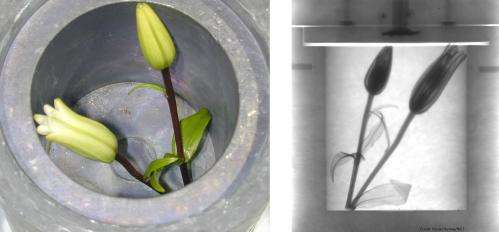DARPA program seeks highly portable neutron sources to complement X-ray capabilities

Seeking to expand the nation's capability to detect and identify materials that are not easily visualized by conventional imaging technologies, DARPA today released an announcement inviting proposals to develop portable, next-generation imaging tools that combine the complementary benefits of X-ray and neutron radiography.
X-Ray imaging has proven invaluable in a host of military and commercial applications—from spotting tiny cracks in aircraft wings, to making medical diagnoses, to scanning passengers' bags to keep the flying public safe. As useful as X-ray scanning is, however, it is limited in what it detects. For example, while X-ray radiography can highlight heavier chemical elements very well (think of shiny silver fillings on a dental X-ray), it's not very good at revealing lighter elements, such as hydrogen. That's why X-ray radiography machines are generally "blind" to water or other liquids.
By contrast, neutron radiography—which uses neutrons to image objects—is very good at visualizing lighter elements and liquids, in some cases even identifying a substance's atomic makeup. Unfortunately, neutron sources are not nearly as portable and practical as X-ray machines, typically extending up to tens of meters in length and requiring powerful energy sources to generate the neutrons.
DARPA's new Intense and Compact Neutron Sources (ICONS) program seeks to develop a portable unit able to generate both neutrons and X-rays. Such a device would harness the complementary strengths of the two imaging sources and enable much more detailed radiography in field settings.
"We're looking for innovative designs and construction methods to shrink a neutron accelerator from 10 meters or longer down to 1 meter or less, similar to the size of portable X-ray tubes today," said Vincent Tang, DARPA program manager. "Creating a high-yield, directional neutron source in a very compact package is a significant challenge," Tang added. "But a successful ICONS program would provide an imaging tool with significant national security applications, able to deliver very detailed, accurate internal imaging of objects in any setting."
For example, Tang said, ICONS could enable non-destructive evaluation of military equipment with greater fidelity than X-rays, revealing water penetration and corrosion in aircraft wings and welds on ships. Neutron imaging could also help detect explosives and contraband by identifying the chemical and atomic make-up of an object or its contents. And it could assist in forensics and attribution, such as differentiating sources of ammunition through imaging of the propellant fill levels.
Provided by DARPA




















